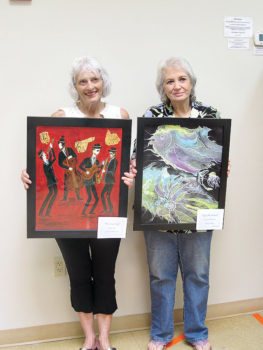 Marianne Graff
Marianne Graff
Versatility! Vivid colors! Fast drying time! The acrylic medium has it all and contemporary artists were quick to notice. This second article in a series examines the work of various artists and the surprising ways they have used acrylics.
Acrylics can be mixed with other mediums or drafted from other sources. An article, 11 Famous Artists Who Paint with Acrylics, details how Robert Motherwell “mixed his paints with graphite and charcoal for those signature shapes and startling blackness” in Elegy to the Spanish Republic No. 110. Another artist Roy Lichtenstein “brought comic book Ben-Day dots and pop culture drama to canvas” and utilized acrylics as in Drowning Girl (Artistsnetwork).
Acrylic artists fully embraced the new medium, and hastened to expand their horizons. In her painting, Canyon, Helen Frankenthaler used blots and drips to achieve bold colors. Mark Rothko used simple shapes and color to convey the extent of human emotion as in No. 13 (White, Red on Yellow). Andy Warhol incorporated the new medium into his innovative designs. Campbell Soup Cans cemented his influence in pop culture by uniting the mundane with art. Artist Maurizio Cattelan said, “That’s the greatest thing about Warhol: the way he penetrated and captured our world, to the point that distinguishing between him and our everyday life is basically impossible” (Wikipedia).
Leading artists today embrace the benefits of acrylics. For Katia Zhukova, as in Frances, the fast-drying nature of the acrylic medium “is perfect for her technique which uses many quick textured layers applied with palette knives and brushes.” Randy L. Honerlah used abstraction and the interplay of light and dark colors to express his worldview in Letting Go. Jerry Smith applies built-up layers of texture and details over larger shapes with all kinds of marking tools: cardboard; scraping tools; stamping objects; brushes and charcoal pencils as illustrated in No. 16 Harbor Alliance. Finally, Fred Schollmeyer uses heavy body acrylics thinned with water in order to utilize an airbrush technique. In his work, No. 20 Frozen Ford Fairlane, he also used a frisket stencil plus a small brush (Artistsnetwork).
Acrylic artists commonly use paper grounds for their paintings. Beth Williams writes about abstract and non-objective painters in The Magnificent Seven. Denise Athanas produced her mixed media, Galaxy on paper and featured color to lead the viewer through the painting; Carol Staub applied acrylic to paper in Portal No. 6 and utilized changes in value to guide the viewer; Donna Watson detailed her quest to better understand her Japanese heritage in The Zen of Discovery. With a brayer, she spreads acrylics onto Japanese washi and next creates a patchwork quilt (boro) effect as in Collage 4. Finally, “I then scratch, lift, rub and scrape layers of paint to reveal the hidden ‘past’ of my painting” (Watercolor Artist Magazine).
PebbleCreek acrylic artists are similarly pursuing their creative goals in various, highly imaginative ways. Several artists are exhibiting through the summer. You are invited to view their paintings in the Creative Arts Center and in the Tuscany Falls and Eagle’s Nest clubhouses.
